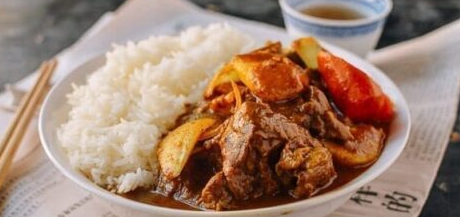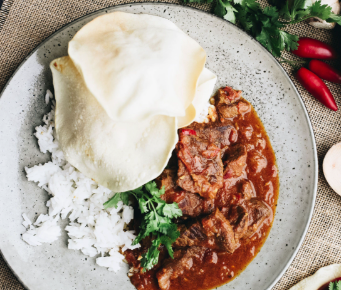Beef Curry Recipes
The history of curry dates back thousands of years, evolving from simple spiced dishes in India to becoming a much-loved global dish. The word 'curry' derives from the Tamil word 'kari', which originally meant sauce or a relish for rice. Since its beginnings, this popular dish has travelled and transformed, carried by traders, conquerors and migrants across the globe, weaving its way into the fabric of countless cultures.
Come with us on a culinary journey as we traverse continents exploring the popularity of beef curry around the world.
Understanding the Basics of Beef Curry
Common Ingredients in Beef Curry:
While the specific ingredients can vary widely depending on the regional recipe, certain elements are common in most beef curry dishes:
- Beef: The star of the dish, beef is typically cut into bite-sized chunks, allowing it to absorb the flavours of the sauce.
- Spices: Core spices may include turmeric, cumin, coriander powder, and chilli powder, mustard seeds while more specific curry powder blends might feature garam masala, cardamom, cinnamon, cloves and nutmeg.
- Herbs: Freshly chopped coriander, curry leaves or Thai Basil leaves are often added for an extra layer of flavour.
- Aromatics: Onions, garlic, fresh ginger, and tomato puree form the flavourful curry paste, which is the base of many curry dishes.
- Liquids: Tomatoes, coconut milk, cream or yoghurt are commonly used to create the curry sauce, each adding a distinct character and richness to the dish.
- Additional Ingredients: Potatoes, carrots, bell peppers, peas or paneer cheese are sometimes included to add texture and variety.
Choosing the Right Cut of Beef:
The choice of beef cut is crucial in crafting a succulent beef curry. Here are some considerations:
- Tougher Cuts: Beef curry is an ideal dish for tougher, more flavourful cuts like chuck or brisket. These cuts are rich in connective tissues that break down during the slow cooking process, resulting in tender, flavorful meat.
- Marbling: Look for cuts with good marbling. The fat within the meat melts during cooking, imparting richness and helping to carry the complex flavours of the spices throughout the dish.
- Size of Pieces: The beef should be cut into uniform pieces to ensure even cooking. Smaller pieces are ideal for quicker cooking curries, while larger chunks are better for recipes that require slow simmering.
What is the Best Cut for Beef Curry Recipes?
The best cut of beef for beef curry recipes is typically a tougher cut that benefits from slow cooking, which breaks down the connective tissues, resulting in tender, flavourful meat. Here are some top choices:
- Chuck Steak: This cut is well-marbled with fat, which not only adds flavour but also helps the meat stay moist and tender during the long cooking process. Chuck roast breaks down beautifully, making it ideal for curries.
- Brisket: Brisket is known for its rich flavour and becomes incredibly tender when cooked slowly. It is another excellent choice for curries, as its texture holds up well to the spices and sauce.
- Shank: Beef shank, which comes from the leg portion, is rich in connective tissues and ideal for a slow-cooked beef curry recipe.
- Short Ribs: Beef short ribs can also be a good option for curry. They are flavorful and become very tender when cooked slowly, adding a luxurious feel to beef recipes.
- Stewing/Braising Steak: Often sold as 'stew meat' or 'diced beef,' these cuts are typically from the chuck or round part of the animal. They are budget-friendly options that become tender and flavourful when simmered in curry.

When preparing beef curry, it is important to cut the beef into uniform pieces to ensure even cooking. Slow cooking at a lower temperature, either in a slow cooker, on a stovetop or in a Dutch oven, is key to transforming these tougher cuts of meat into tender, succulent pieces that absorb the rich flavours of your curry sauces.
Regional Variations of Beef Curry
There are many different regional variations of this popular dish and here we list a few:
1. South Asian Beef Curries:
South Asia, with its rich tapestry of cultures and cuisines, offers a variety of beef curries, each with its unique blend of spices and cooking techniques.
- Rogan Josh (India): Originally from Kashmir, Rogan Josh is a fragrant curry characterised by its deep red colour, achieved through the liberal use of Kashmiri chillies. This dish typically features tender chunks of beef cooked in a sauce made with yoghurt, ginger, garlic, and an array of spices including cardamom, cinnamon and cloves. Authentic Rogan Josh emphasises a balance between the heat of the chillies and the aromatic spices, creating a complex and richly flavoured dish.
- Beef Vindaloo (India): Hailing from Goa, Beef Vindaloo is known for its fiery spiciness and tangy flavour, courtesy of the use of vinegar and a plethora of spices like cumin, mustard and fenugreek. The key to an authentic Vindaloo lies in its marination process, where beef is marinated in vinegar and spices, tenderising the meat and infusing it with bold flavours before cooking.
- Beef Bhuna (Bangladesh/Pakistan): Beef Bhuna is a popular dish where the meat is cooked in its juices and spices until it achieves a rich, concentrated flavour. The process involves frying the beef with spices and then simmering it to allow the flavours to meld together. The result is a dry curry with a thick coating of spice around the tender beef pieces.
2. Southeast Asian Beef Curries:
The beef curries of Southeast Asia stand out for their plentiful use of local herbs, spices and cooking methods, offering a distinct palate of flavours.
- Massaman Curry (Thailand): This Thai curry blends the warmth of Indian spices with the bright flavours of Thai ingredients like lemongrass and galangal. Massaman Curry typically includes potatoes, peanuts, and coconut milk, creating a rich, savoury, and slightly sweet dish. The slow cooking process allows the beef to become tender, absorbing the complex flavours of the curry.
- Beef Rendang (Indonesia/Malaysia): Originating from the Minangkabau people of West Sumatra, Beef Rendang is a dry curry where the meat is slow-cooked in coconut milk and a paste of mixed spices, including lemongrass, galangal and turmeric. The cooking process is a slow reduction, resulting in a tender, flavour-packed dish that is both aromatic and intensely satisfying.
3. Other Global Beef Curry Variations:
Beyond Asia, beef curry takes on new forms, incorporating local ingredients and culinary traditions.
- Caribbean Beef Curry: In the Caribbean, beef curry features a blend of local spices and herbs, with allspice and thyme playing prominent roles. The use of coconut milk and Scotch bonnet peppers adds a unique island twist to the dish, offering a spicy, flavourful and hearty meal.
- Japanese Beef Curry: In Japan, curry is a beloved comfort food, with a milder and thicker sauce compared to its South Asian counterparts. Japanese beef curry incorporates a roux-based sauce and often includes vegetables like carrots and potatoes. While it is less spicy, it is deeply savoury, offering a unique interpretation of curry that is both comforting and satisfying.

Each of these regional variations of beef curry offers a glimpse into the cultural and culinary diversity of the dish. Whether it's the aromatic spices of South Asia, the rich coconut-based curries of Southeast Asia, or the unique adaptations found in the Caribbean and Japan, beef curry remains a beloved dish worldwide, celebrated for its versatility and rich flavours.
Cooking Tips for a Perfect Beef Curry
Crafting the perfect beef curry involves understanding the ingredients, the cooking process, and how different techniques can influence the final dish. Here are some essential tips and tricks to elevate your beef curry:
Marinating Beef:
- Enhanced Flavour and Tenderness: Marinating beef not only infuses it with flavour but also helps to tenderise the meat. Use acidic ingredients like yoghurt, vinegar, or lime juice in your marinades, as they break down proteins, making the beef more tender.
- Timings: For best results, marinate the beef for at least a few hours, though overnight marination is ideal. This gives the spices time to penetrate the meat and meld their flavours.
- Seal in a Bag: Place your marinating beef in a ziplock bag or covered bowl to ensure it is evenly coated and the flavours are locked in.
Choosing the Right Spices:
- Quality Matters: Use fresh, high-quality spices for the best flavour. Ground spices lose their potency over time, so if you can, roast and grind your own from whole spices.
- Roast for Depth: Dry roasting spices before grinding them will enhance their flavours and aromas, adding a completely new dimension to your curry.
- Layering Flavours: Add spices at different stages of cooking to build a more complex flavour profile. Start with a base of aromatic spices sautéed in oil, then add more delicate spices towards the end of cooking to preserve their flavours.
Cooking Techniques:
- Slow Cooking: Beef curry benefits from slow, gentle cooking, allowing the meat to become tender and the flavours to develop fully. Use a low heat setting and allow the curry to simmer until the beef is soft and the sauce has thickened.
- Browning the Meat: Sear the beef before adding it to the curry to lock in juices and add a layer of flavour from the caramelisation process.
- Consistent Heat: Maintain a consistent temperature while cooking to ensure the beef cooks evenly and the spices meld properly.
Traditional vs. Modern Cooking Appliances:
- Traditional Methods: Cooking curry in a traditional pot or Dutch oven over a stove can provide better control over the cooking process, allowing you to adjust the heat as needed and stir the curry to prevent sticking.
- Pressure Cookers: Modern pressure cookers or Instant Pots can significantly reduce cooking time while still delivering tender beef. However, the rapid cooking method might not allow flavours to develop as deeply as with slow cooking.
- Slow Cookers: Slow cookers are ideal for beef curry, as they maintain a consistently low temperature and allow flavours to develop over several hours. A slow cooker beef curry recipe is perfect for tougher cuts of beef, ensuring they become tender and flavourful in this method of cooking.

By understanding these tips and techniques, you can enhance the flavour and tenderness of your beef curry, regardless of the regional style you are cooking. Remember, making curry is an art and a science, where patience and attention to detail will lead to deliciously rewarding results.
Serving and Pairing Suggestions for Beef Curry
- Accompaniments: Beef curry's rich flavours pair beautifully with a variety of side dishes. Rice and naan bread are typical accompaniments to this popular curry.
- Vegetable Sides: To balance the richness of the curry, consider serving it with light vegetable sides. A simple cucumber raita, a tangy achar (pickle), or a fresh salad can add a refreshing element to your meal.
Rice Varieties:
Different types of rice can complement the flavours and textures of beef curry:
- Basmati Rice: Its long, slender grains and fragrant aroma make basmati a classic choice, especially for Indian-style curries.
- Jasmine Rice: Known for its delicate, floral aroma, jasmine rice pairs well with Southeast Asian curries.
- Brown Rice: For a healthier option, brown rice offers a nutty flavour and chewy texture, which stands up well to hearty curries.
Bread Pairings:
- Naan: This fluffy, leavened bread is ideal for mopping up rich sauces.
- Roti or Chapati: These unleavened flatbreads offer a lighter, more wholesome option for scooping up curry.
- Paratha: Layered and flaky, paratha adds a delightful texture to your meal.

With the right pairings and accompaniments, you can elevate your beef curry experience, turning it into a memorable and satisfying meal that is guaranteed to have your friends coming back for more.
Why Quality Meat Matters
Using quality ingredients in cooking is pivotal because it directly influences the dish's flavour, texture and nutritional value. High-quality ingredients, such as Scotch Beef, which is sourced from ethically raised animals, undoubtedly carry a superior taste profile, boasting richer, more nuanced flavours that will elevate any meal.
This is why you should choose to cook with Scotch Beef:
- Enhanced Flavour: Quality beef, particularly from cattle that have been grass-fed and raised in optimal conditions, has a richer and more nuanced flavour compared to standard beef. The diet and environment of the cattle directly influence the taste and texture of the meat, making it more desirable for dishes where beef is the star ingredient.
- Tenderness and Texture: The care in raising quality beef cattle, including their diet and living conditions, often results in meat that is more tender and enjoyable to eat. This is particularly important in dishes like beef curry, where the meat needs to be succulent and tender after cooking.
- Nutritional Value: Higher-quality beef, like Scotch Beef, is more nutritious, containing a better balance of omega-3 and omega-6 fatty acids, especially in grass-fed varieties. It also has higher levels of vitamins and antioxidants, contributing to a healthier diet.
- Cooking Results: Quality beef cooks more evenly and produces better results. It is less prone to becoming tough or chewy, which is crucial for slow-cooked dishes like curry that require the meat to be soft and flavourful.
- Sustainability and Ethical Considerations: Choosing quality beef means supporting sustainable and ethical farming practices. Many high-quality beef producers adhere to strict animal welfare standards and sustainable farming practices, which is an important consideration for many consumers.

Whether you are cooking a slow cooker beef curry recipe or a centrepiece Sunday roast for family and friends, using quality beef such as Scotch Beef with UKGI status will undoubtedly elevate the dish, enhancing its flavours, textures and the overall dining experience. It is not just about the taste; it is also about the quality of life for the animals, the impact on the environment, and the health benefits for the consumer.
Where Can I Buy Scotch Beef Near Me?
The good news is that you don't have to travel miles to get your hands on this exceptional quality meat.
With the help of our user-friendly map, you can now find premium-quality Scotch Beef right on your doorstep! Simply enter your postcode, and the map will guide you to the nearest Scotch meat supplier.
So what are you waiting for? Let's get cooking!
What's The Scotch Difference?
Let us take you on a journey into what makes Scotch Beef, Scotch Lamb and Specially Selected Pork so special, and how we produce such high-quality meat renowned and enjoyed worldwide.


- © MakeitScotch 2026
- Cookies
- Privacy
- Terms of Use
Site by Art Department
